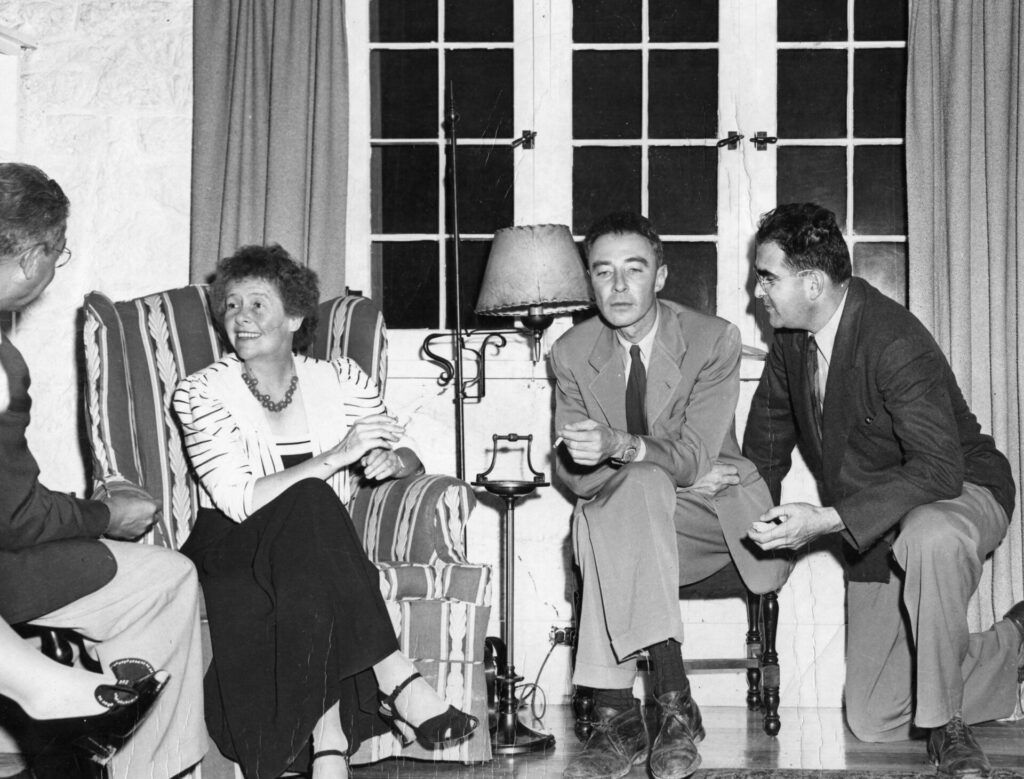Post-‘Oppenheimer,’ what we should do to dismantle the nuclear Doomsday Machine
By Ivana Nikolić Hughes | July 21, 2023
 From left to right, physicist I.I. Rabi; Dorothy McKibben, who ran the Santa Fe office for the Los Alamos laboratory during World War II; J. Robert Oppenheimer; and physicist Victor Weisskopf converse in September 1946. Photo credit: American Institute of Physics Emilio Segrè Visual Archives, Physics Today Collection.
From left to right, physicist I.I. Rabi; Dorothy McKibben, who ran the Santa Fe office for the Los Alamos laboratory during World War II; J. Robert Oppenheimer; and physicist Victor Weisskopf converse in September 1946. Photo credit: American Institute of Physics Emilio Segrè Visual Archives, Physics Today Collection.
There is a scene described in the book American Prometheus, on which the film Oppenheimer was based, where I.I. Rabi, the great Columbia University physicist and Nobel laureate, and J. Robert Oppenheimer are sitting in Rabi’s Riverside Drive apartment in New York City in December of 1945. The pair watches “the ice floes bathed in yellow and pink floating down the Hudson River.” Later, while smoking their pipes, they discuss international control of nuclear weapons. It didn’t take long after the use of atomic bombs in attacks on Hiroshima and Nagasaki for the two physicists to recognize that continued national possession of these weapons presented a unique threat to humanity.
Nearly 78 years later, the same concerns fill the living room where the conversation between Oppenheimer and Rabi took place. The pipes are gone and the characters have changed; they now include me and my husband, Emlyn, who as a professor of physics at Columbia “inherited” Rabi’s apartment, and many anti-nuclear activists, diplomats, and students. Gathering between the same walls, windows, and built-in bookcases, we feel the same underlying anguish about the existential threat that nuclear weapons pose, but if anything, our concerns are even greater than what Oppenheimer and Rabi could have imagined in 1945. This is because of new revelations about the potential scale of the death and destruction that nuclear warfare would cause.
Having seen the devastation atomic bombs wrought on Japan, Oppenheimer, Rabi, and many Manhattan Project scientists understood that the continued development of nuclear weapons by the United States would inevitably lead to an arms race with the Soviet Union. They also understood that it was in principle possible—as the United States demonstrated less than a decade later—to make hydrogen bombs thousands of times more powerful than the weapons used in the Hiroshima and Nagasaki attacks. This of course meant that the scale of deaths from blast, fire, and radiation effects would move from hundreds of thousands to hundreds of millions of people.
But incinerated, burned, and sickened civilians, flattened cities, and barren lands would not be the only, nor arguably the worst, legacy of nuclear war. That distinction is reserved for a concept called nuclear winter, a discovery first made in the early 1980s, long after Oppenheimer had passed away, but before Rabi’s death in 1988. The idea is relatively simple: nuclear attacks on cities will lead to enormous, high-temperature fires, which will inject soot high into the stratosphere, where it will remain for years, blocking incoming sunlight, causing temperatures to drop significantly, and leading to dramatic global reductions in food availability. Billions of people will die of starvation, according to the latest studies by Alan Robock and his colleagues at Rutgers University and elsewhere.
Yes, fighting a nuclear war is equivalent to national suicide. Make that planetary omnicide.
In the words of Daniel Ellsberg, who passed away last month: “What is missing—what is foregone—in the typical discussion and analysis of historical or current nuclear policies is the recognition that what is being discussed is dizzyingly insane and immoral: in its almost-incalculable and inconceivable destructiveness and deliberate murderousness, its disproportionality of risked and planned destructiveness to either declared or unacknowledged objectives, the infeasibility of its secretly pursued aims (damage limitation to the United States and allies, “victory” in two-sided nuclear war), its criminality (to a degree that explodes ordinary visions of law, justice, crime), its lack of wisdom or compassion, its sinfulness and evil.”
US nuclear policies are sheer madness and must be completely reconsidered.
The trees have grown far taller in Riverside Park than they were back in 1945, so even in winter, with the leaves gone, we have a hard time seeing the river. December also doesn’t feature pink ice floating on the Hudson in the evenings; it is simply too warm now. But the conversations in our living room continue and focus on how to get to the point of assured survival of humanity in the nuclear age.
One solution involves dismantling what Ellsberg calls the “Doomsday Machine” that the United States, Russia, and, to a lesser degree, the other seven nuclear weapon states have built. This would involve dramatic reductions in current arsenals, as well as consistent efforts to reduce the possibility of inadvertent war, including the institution of no-first-use policies. Another, arguably more ambitious approach is the total abolition and elimination of nuclear weapons through the UN Treaty on the Prohibition of Nuclear Weapons. The latter would effectively do what Oppenheimer and Rabi imagined in December of 1945: put nuclear weapons under international control and then eliminate them. As Nelson Mandela said in his retirement address at the UN in 1998: “why do they need them anyway!”
Together, we make the world safer.
The Bulletin elevates expert voices above the noise. But as an independent nonprofit organization, our operations depend on the support of readers like you. Help us continue to deliver quality journalism that holds leaders accountable. Your support of our work at any level is important. In return, we promise our coverage will be understandable, influential, vigilant, solution-oriented, and fair-minded. Together we can make a difference.
Keywords: Daniel Ellsberg, I.I. Rabi, J. Robert Oppenheimer, doomsday machine
Topics: Nuclear Risk, Nuclear Weapons















Nelson Mandela’s farewell address to the UN where he urged us to abolish nuclear weapons was responding to a global campaign of the Abolition 2000 network, sending hundreds of letters to Mandela, before the internet, asking him to call for the elimination of nuclear weapons in his farewell address!. Ironically, the London Guardian ran a headline, “Nelson Mandela Calls for the Elimination of Nuclear Weapons”, while the NY Times never mentioned the content of his speech, only informing their readers, far from page 1, that Mandela was retiring from the government and gave his final talk at the UN. No… Read more »